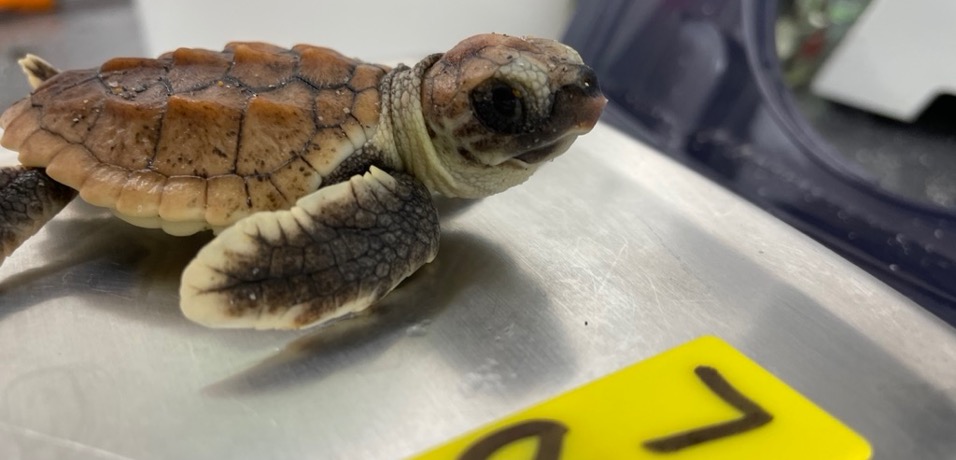
Author: Gael-Lynn Laguerre
Date: July 18, 2023
It’s hatchling time! The 2023 nesting season is officially underway as the lab begins filling up with the three species of sea turtles that we work with at the FAU Marine Lab. Our current “shell” count sits at 120 (40 loggerheads, 50 leatherbacks, 30 greens) and is growing daily. While many are aware of our mission, few have seen the process up close as new hatchlings arrive at their home for the next 2 to 4 months. We have been honored with the opportunity to observe and learn more about three select species: loggerhead, leatherback, and green sea turtles. Our mission is to share Florida Atlantic University’s contribution to sea turtle conservation and coastal or marine challenges with the public. So, here is a mini recap of what to keep in mind when visiting the Marine Lab this year!
Why are Hatchlings in the Lab?
Sea turtle hatchlings are raised within the lab to determine the sex ratios naturally produced on our beaches. Baby sea turtles do not have an X or a Y chromosome (like we do); instead, their sex is determined during the incubation period by the environment surrounding the nest. The temperature of the nest environment determines whether an embryo will develop as either a male or female. The warmer the sand, the more females are produced; cooler temperatures produce more males. As a result of the increasing global temperatures and climate change, sea turtles now have a much more female-dominated sex ratio in the wild, which could be troublesome for the future. This research is an essential step in both preservation and conservation, which is why the FAU Marine lab has been investigating these ratios for the past two decades.
Why are Hatchlings in Baskets or Tethered?
In the lab, each sea turtle species is cared for differently depending on their specific needs. While they are guests in the lab, we emulate their life at sea to ensure their stress is low, and they are safe. Leatherbacks are sensitive creatures that live exclusively in the open ocean at all life stages, and only females return to shore when it is time to nest. Hence, they rarely interact with boundaries, and so, do not recognize physical barriers like tank walls. We keep leatherbacks on tethers, so they don’t face injury running into the walls. The tether almost functions as a little marine treadmill for them, providing the opportunity to swim continuously like they would in the open ocean at this life stage! Clear curtains also surround our leatherback tank area to reduce airborne bacteria from entering their tanks. These are extra protections we take to ensure their health and happiness in the lab. Leatherbacks are not accustomed to our “day-to-day" air and coastal water, and so, we take extra care to keep both very clean.
Loggerhead and green sea turtles, however, do not face most of those challenges. As little turtles, they head out to the open ocean and eventually recognize diverse barriers such as mats made of algae or seagrass and coral reefs. These little turtles like to hide in floating mats of seaweed. Years later, they return to coastal waters and spend even more years growing up nearshore. During their time with us in the lab, loggerheads and green turtles live in baskets that emulate the spaces in Sargassum mats (seaweed beds) they would use in the ocean. Greens and loggerheads spend the first year or more of their life hiding within these little “cubbies” of vegetation, opportunistically feeding on algae and small invertebrates. The baskets are a great substitute for their little home sweet homes in the wild!
Where We Stand Today
Despite the urgency of the species’ situation, the FAU Marine Lab remains one of the only labs in the world estimating hatchling sex ratios in this way, and we are currently the only lab in the world that has been successfully raising leatherbacks. Come visit our shelled friends, and stay tuned for frequent hatchling updates by following the Marine Lab on Instagram and Facebook @faumarinelab on both platforms.
